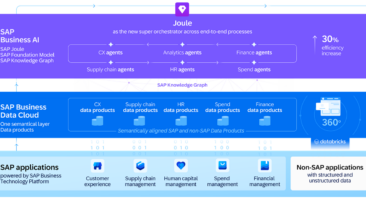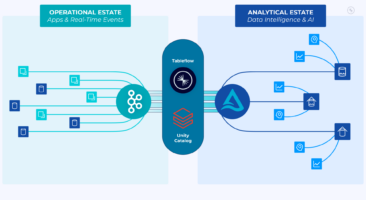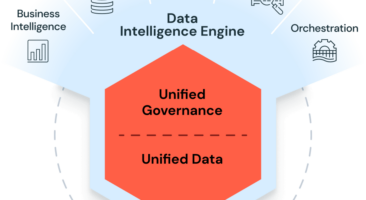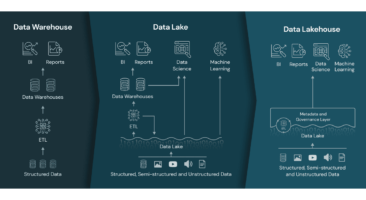The Data-Driven Future: How Cloud Migration Unlocks AI and Competitive Edge
Organizations increasingly turn to cloud migration to gain an edge in today’s digital world. Organizations realize the cloud can boost innovation, streamline business processes, and drive data-driven decisions. This article will examine the impact of cloud migration and AI adoption on the organization. Let’s explore the world of AI and cloud migration to see what limitless possibilities are available for modern businesses.
Catalyst for Innovation: Cloud Migration
Cloud migration is a great way to jumpstart technological innovation. It provides scalability, agility, and a platform for advanced analytical tools. Cloud migration reduces the limitations of legacy infrastructures and allows businesses to innovate. Cloud-based capabilities enable organizations to leverage unlimited resources to solve complex problems once thought impossible.
Organizations that master the complexities of cloud integration unlock an entire world of machine learning and predictive analytics. The alignment of operations with the cloud creates a paradigm in which data is the currency for innovation. This transformed ecosystem allows organizations to adapt dynamically to market changes while pioneering new strategies and laying the groundwork for an insurmountable edge.
Collect more data
One of the key benefits of cloud migration is the ability to collect and store vast amounts of data from various touchpoints and systems. With cloud-based data storage and processing capabilities, businesses can quickly gather and consolidate data from multiple sources, including customer interactions, sales transactions, and operational metrics.
Organizations can comprehensively view their operations and customer behavior by collecting more data. This data can then be used to uncover valuable insights, identify patterns, and make informed decisions. Additionally, having access to a larger dataset allows for more accurate and reliable analysis, leading to better predictions and actionable recommendations.
Cloud migration enables businesses to scale their data collection efforts effortlessly, accommodating the growing volume and variety of data generated in today’s digital landscape. With the ability to collect more data, organizations can stay ahead of the competition, drive innovation, and make data-driven decisions that fuel their success.
Breaking Data Silos
Data silos pose a significant challenge for organizations as they hinder the ability to have a unified view of data and make informed decisions. Cloud migration plays a crucial role in breaking down these silos by providing a centralized platform for data storage and integration. With cloud-based data warehouses and integration tools, organizations can consolidate data from various sources into a single repository, enabling better collaboration and data-driven decision-making.
Cloud migration not only breaks data silos but also simplifies the process of connecting and harmonizing data from different sources. Cloud-based data integration tools establish seamless data pipelines, ensuring smooth data flow across systems and departments. This integration capability enhances data quality, reduces duplication, and improves overall data governance.
By leveraging cloud migration to break data silos, organizations can unlock the full potential of their data assets. They can gain a holistic view of their data, uncover valuable insights, and drive innovation. Additionally, the ability to access and analyze the same set of data fosters a culture of collaboration and data-driven decision-making. Cloud migration empowers organizations to improve operational efficiency and gain a competitive edge in today’s data-driven landscape.
Access to the Latest Technology
Cloud migration allows businesses to access and leverage the latest technology advancements without significant upfront investments. Cloud service providers, such as Amazon Web Services (AWS), continuously innovate and introduce new services and features that can be easily integrated into existing cloud environments.
Organizations can use cutting-edge technologies like artificial intelligence (AI), machine learning (ML), and big data analytics by migrating to the cloud. These technologies can help businesses gain valuable insights, automate processes, and make data-driven decisions.
For example, AWS offers a wide range of AI and ML services, including Amazon Rekognition for image and video analysis, Amazon Comprehend for natural language processing, and Amazon SageMaker for building and deploying ML models. Businesses can enhance their operations, improve customer experiences, and drive innovation by utilizing these services.
Cloud migration empowers organizations to stay at the forefront of technology advancements, enabling them to remain competitive in their respective industries. By embracing the cloud, businesses can access the latest technology offerings, leverage innovative solutions, and stay ahead of the curve in an ever-changing digital landscape.
Improving Experimentation and Innovation
Cloud migration allows businesses to improve experimentation and innovation by providing the flexibility to provide temporary resources quickly. Traditional on-premises infrastructure often requires significant time and effort to provision additional resources for experimentation or innovation projects. This can hinder the agility and speed at which businesses can test new ideas and drive innovation.
In contrast, cloud service providers like Amazon Web Services (AWS) offer on-demand resource provisioning, allowing businesses to spin up and tear down resources as needed quickly. This capability enables organizations to experiment with new technologies, test hypotheses, and iterate on ideas without the constraints of long lead times or upfront investments.
Businesses can allocate resources for experimentation and innovation projects by leveraging the cloud’s scalability and elasticity. This means teams can have dedicated environments to explore new concepts, develop prototypes, and conduct tests without impacting production systems.
Cloud providers offer various services and tools that facilitate experimentation and innovation. These services enable businesses to quickly provision the necessary resources for experimentation and innovation, allowing teams to focus on driving creativity and pushing boundaries.
The ease of provisioning temporary resources in the cloud empowers businesses to foster a culture of experimentation and innovation. It enables teams to iterate rapidly, test new ideas, and quickly bring innovative solutions to market. By leveraging the cloud’s flexibility and scalability, organizations can stay ahead of the competition and drive continuous improvement and growth.
AI Advancement Through the Cloud
AI advancements are catalyzed by cloud migration, bridging compute power with sprawling datasets to spark innovation. The synergies created between robust cloud infrastructures and AI algorithms are revolutionizing industries, unlocking new potentials for process automation and insight generation.
By integrating AI with cloud technologies, organizations gain scalability and adaptability in their AI initiatives. This combination of cloud elasticity with AI’s predictive capabilities sets the stage for businesses to transform and capitalize on previously untapped opportunities, fostering an environment ripe for invention and strategic advantage.
AI-driven “smart analytics” and “intelligent automation” redefine operational agility, pushing the envelope in delivering value to an organization’s stakeholders.
Unleashing Machine Learning Potential
Cloud migration is the linchpin that activates machine learning’s transformative power. The cloud effortlessly houses voluminous data while offering the computing power necessary to sift through and learn from it.
The cloud environment accelerates the development and deployment of machine learning models, encouraging iterative experimentation and faster refinement. Crucially, this empowers organizations to pivot quickly and stay ahead in dynamic markets.
The fusion of cloud agility and machine learning innovation cultivates an ecosystem where predictive insights and intelligent decision-making flourish —imperative for a competitive edge. These insights can be turned into actionable intelligence swiftly and efficiently.
Significantly, the cloud democratizes access to machine learning by abstracting the complexity of high-performance computing. Even entities with limited technical resources can harness its potential for business growth.
Embrace the cloud to unlock the full spectrum of machine learning—where complex data transforms into strategic foresight, catalyzing robust, data-driven decisions.
Real-Time Analytics and Insights
In the world of cloud computing, speed is paramount. Reduced data latency introduces a new era of real-time analytics, significantly transforming how businesses make decisions. Modern cloud platforms enable rapidly merging various data streams, facilitating complex analyses without significant delays. This swift processing allows advanced algorithms to offer insights as new data emerges or changes occur instantly.
Organizations gain an invaluable tool for immediate understanding of market trends and customer behaviors by utilizing such rapid analytics. Analyzing data in real-time enables companies to develop proactive strategies and quickly adapt to market changes, enhancing their agility and responsiveness.
Furthermore, the continuous influx of real-time data in the cloud creates an ideal environment for evolving machine learning models. These models can adjust and learn as new data flows in, forming the foundation of a responsive and intelligent business ecosystem.
Adopting cloud-enabled real-time analytics provides a tangible competitive edge. It enhances an organization’s strategic flexibility and boosts operational efficiency, allowing for more informed and quicker decision-making in a fast-paced business environment.
Personalized Customer Experiences
The shift to cloud migration has dramatically elevated the potential for delivering personalized customer experiences.
- Real-time Data Processing: Cloud technology enables businesses to analyze customer behavior as it unfolds in real-time. This immediate processing capability allows a more accurate understanding of customer needs and preferences.
- Advanced Predictive Analytics: Machine learning algorithms powered by the cloud excel in predicting future customer behaviors and preferences. These predictive insights enable businesses to anticipate customer needs, often even before the customers themselves are aware of them.
- Seamless Omnichannel Integration: The cloud facilitates a unified customer journey across various platforms and touchpoints. This integration ensures consistency in customer experience, whether they interact with a brand online, in-app, or in physical stores.
- Customized Communication: Cloud analytics empower businesses to craft messages and offers tailored to individual customer profiles. This level of customization ensures that communications are relevant, engaging, and more likely to result in positive customer responses.
- Enhanced Feedback Mechanisms: Cloud platforms enable responsive systems that can learn and evolve from each customer interaction. This continuous learning loop leads to a constant improvement in service offerings and customer engagement strategies.
By leveraging these cloud-based capabilities, businesses can deliver services with unprecedented precision and personalization. This approach not only enhances customer satisfaction but also provides a significant competitive advantage by catering to each customer’s unique preferences and expectations.
Business Process Automation
Business process automation (BPA) is a key benefit of cloud migration, enabling organizations to leverage collected data, data integration, and robotic process automation (RPA) to streamline and optimize their operations.
By collecting and analyzing data from various sources, businesses can gain valuable insights into their processes and identify areas for improvement. This data-driven approach allows organizations to make informed decisions and automate repetitive tasks, reducing manual effort and increasing efficiency.
Data integration is crucial in business process automation by connecting disparate systems and enabling seamless data flow. With cloud-based integration tools, organizations can harmonize and consolidate data from different sources, ensuring that information is accurate, up-to-date, and readily available for automated processes.
Robotic process automation (RPA) takes automation further by using software robots or “bots” to perform repetitive tasks. These bots can mimic human actions, such as data entry, document processing, and data validation, freeing employees’ time for more strategic and value-added activities.
Combining collected data, data integration, and RPA enables organizations to automate and optimize their business processes, leading to increased productivity, reduced costs, and improved customer experiences. By embracing these technologies through cloud migration, businesses can unlock the full potential of automation and drive innovation in their operations.
Unlocking Generative AI
Generative AI offers significant potential in automation and unstructured data understanding, providing organizations with advanced capabilities in sentiment detection, data extraction, understanding intent, generating emails and messages, content creation, personalization, and automating complex decision-making tasks.
- Sentiment Detection: Its advanced natural language processing (NLP) capabilities enable accurate interpretation of nuances in human language, which is crucial for assessing customer sentiment quickly and effectively.
- Data Extraction: Generative AI can interpret and organize unstructured data, a task difficult for traditional methods, making it invaluable for gleaning insights from diverse data sources.
- Understanding Intent: AI’s sophisticated NLP models are adept at deciphering the subtleties and intentions in human communication, enhancing responsiveness in customer service.
- Generating Emails and Messages: Trained on extensive language datasets, Generative AI can efficiently produce contextually appropriate and stylistically accurate communication, streamlining correspondence.
- Content Creation and Personalization: Its ability to analyze user data and preferences allows for generating targeted and personalized content, which is key for engaging modern audiences.
- Automating Complex Decision-making Tasks: Generative AI’s rapid data processing and analysis capabilities enable it to provide insightful input for informed decision-making in areas like finance.In summary, the effectiveness of Generative AI in these tasks is due to its advanced language understanding capabilities, ability to process large datasets, and efficiency in generating coherent and contextually relevant outputs. These capabilities make Generative AI a tool for automation and a transformative force in enhancing business processes, decision-making, and customer engagement.
Achieving a Competitive Edge
Migrating to the cloud is not merely a technical change; it’s a strategic enabler that propels businesses into a new performance stratum. With cloud-based data warehousing and advanced analytics at their fingertips, organizations can swiftly pivot data into actionable insights, squeezing the latency out of decision-making and sharpening their competitive edge.
Leveraging cloud capabilities means infusing artificial intelligence (AI) into the core of business processes. This integration transforms data into a strategic asset, driving optimized operations and personalized customer engagements that distinguish industry leaders from the rest of the pack.
Lower Operational Costs
The shift to cloud computing reflects an astute business strategy focused on financial agility.
- Reduced Infrastructure Expenses: By eliminating or reducing on-premises data centers, businesses save on hardware, software, and maintenance costs.
- Scalable Resources: Pay-as-you-go models offered by cloud providers ensure that companies only pay for the resources they consume.
- Energy Efficiency: Cloud data centers optimize power usage more effectively than private data centers, lowering energy bills.
- Automated Updates and Management: Cloud providers are responsible for system updates and maintenance, freeing up internal resources.
- Disaster Recovery Savings: Built-in redundancy and backup protocols in cloud services mitigate the costs associated with business continuity planning. Transitioning away from CapEx-heavy IT investments, companies enjoy OpEx-driven cost structures.Streamlined operations and cloud automation directly translate to lower staffing overheads and operational excellence.
Agile Response to Market Changes
In an ever-shifting marketplace, agility is paramount to maintaining a competitive edge.
As market conditions fluctuate, organizations leveraging cloud technologies exhibit unparalleled adaptability. With cloud-based data stores and computational resources, businesses can immediately harness vast datasets and sophisticated analytics tools. This gives decision-makers timely insights, enabling swift strategic pivots in response to emerging trends and challenges.
Moreover, integrating AI-driven analytics into cloud platforms allows companies to anticipate market shifts more precisely. By continuously analyzing large streams of data, AI algorithms detect nuanced patterns and forecast potential scenarios, facilitating proactive measures rather than reactive responses.
Finally, the cloud’s elastic nature ensures enterprises can scale their operations up or down with minimal friction to align with current demands. This flexibility proves critical in turbulent markets, as businesses can swiftly adjust resource allocation without physical infrastructure constraints, propelling them toward innovative ventures and operational efficiency.
Increased Security
One of the significant advantages of cloud migration is the enhanced security measures provided by cloud service providers like Amazon Web Services (AWS). AWS follows a comprehensive security model encompassing physical, operational, and data security to protect businesses’ valuable assets.
AWS adopts a “Zero Trust” approach to security, meaning no user or system is inherently trusted. This approach ensures that every access request is thoroughly authenticated and authorized before granting access to resources. By implementing strict access controls and authentication mechanisms, AWS helps businesses mitigate the risk of unauthorized access and potential security breaches.
Another security principle followed by AWS is the “Least Privilege” approach. This principle ensures that users and systems are granted only the minimum level of access required to perform their tasks. By adhering to the principle of least privilege, businesses can minimize the potential impact of security incidents and limit the exposure of sensitive data.
In addition to these approaches, AWS provides a wide range of security services and features to enhance the security posture of cloud environments further. These include network security measures such as Virtual Private Cloud (VPC) and security groups, encryption services like AWS Key Management Service (KMS), and monitoring and logging tools like AWS CloudTrail and Amazon GuardDuty.
By migrating to the cloud, businesses can leverage these robust security measures and benefit from the expertise and investments cloud service providers make in maintaining a secure infrastructure. This allows organizations to focus on their core business activities while having peace of mind knowing that their data and systems are protected by industry-leading security practices.
Outperforming Competition through Innovation
In today’s rapidly evolving business landscape, innovation is a key driver of success and a means to outperform the competition. Cloud migration and adopting emerging technologies, such as AI, provide organizations with the tools and capabilities to foster innovation and gain a competitive edge.
By embracing cloud migration, businesses can leverage cloud platforms’ scalability, flexibility, and cost-efficiency to experiment with new ideas, develop innovative solutions, and bring them to market faster. The cloud’s on-demand resources and infrastructure-as-a-service (IaaS) model enable organizations to rapidly scale their operations and test new concepts without significant upfront investments.
Furthermore, integrating AI technologies, such as machine learning and natural language processing, can unlock new opportunities for innovation. AI-powered solutions can automate processes, analyze vast amounts of data, and provide valuable insights that drive informed decision-making.
Cloud migration and AI adoption enable organizations to optimize data warehouses, integrate data seamlessly, and automate key business processes. This empowers businesses to uncover hidden patterns, identify trends, and make data-driven decisions that lead to innovation and improved performance.
Innovation also extends to customer experiences. By leveraging cloud-based technologies and AI, organizations can personalize interactions, deliver targeted content, and provide seamless omnichannel experiences. This level of personalization and convenience sets businesses apart from their competitors and fosters customer loyalty.
Moreover, cloud platforms offer a collaborative environment that encourages cross-functional teams to collaborate, share ideas, and innovate collectively. This collaborative approach fosters a culture of innovation within the organization, where employees are empowered to contribute their unique perspectives and drive creative solutions.
By embracing cloud migration and leveraging AI technologies, businesses can stay ahead of the competition by continuously innovating and delivering value to their customers. The ability to adapt quickly, experiment with new ideas, and leverage data-driven insights positions organizations for long-term success in today’s dynamic and competitive marketplace.
Conclusion
In summary, cloud migration enables businesses to improve experimentation and innovation by providing the ability to provision temporary resources quickly. Unlike traditional on-premises infrastructure, the cloud offers on-demand resource provisioning, allowing organizations to quickly spin up and tear down resources for experimentation and innovation projects. This flexibility eliminates the constraints of long lead times and upfront investments, enabling teams to test new ideas, develop prototypes, and iterate on concepts without impacting production systems. Cloud service providers like AWS offer various services and tools that facilitate experimentation and innovation, further empowering businesses to drive creativity and push boundaries. By leveraging the cloud’s scalability and elasticity, organizations can foster a culture of continuous improvement and bring innovative solutions to the market faster.


















